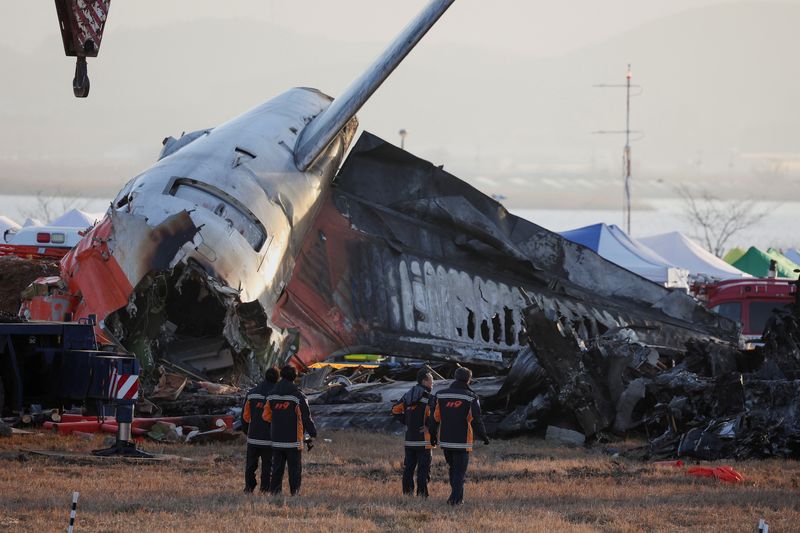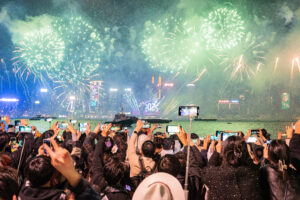South Korean airport embankment in focus after deadly Jeju Air crash

By Hyonhee Shin and Joyce Lee
SEOUL/MUAN COUNTY, SOUTH KOREA (Reuters) – Air safety experts on Tuesday questioned the placement of an airport embankment into which a South Korean passenger jet slammed after skidding past the end of the runway, resulting in the country’s deadliest domestic air disaster.
All 175 passengers and four of the six crew were killed on Sunday when the Jeju Air plane belly-landed at Muan International Airport, ploughed into the sand-and-concrete embankment and burst into a fireball.
What caused the pilot to attempt the landing after declaring an emergency was still under investigation.
But comments in the airport’s operating manual, uploaded early in 2024, said the embankment was too close to the end of the runway and recommended that the location of the equipment be reviewed during a planned expansion.
A transport ministry official said on Tuesday authorities would need to check the document before replying to questions.
Experts criticised the positioning of the embankment, which held navigation equipment.
“Unfortunately, that thing was the reason that everybody got killed, because they literally hit a concrete structure,” Captain Ross Aimer, the chief executive of Aero Consulting Experts, told Reuters. “It shouldn’t have been there.”
Meanwhile, police worked to identify victims while impatience rose among families gathered at the airport as they waited for the bodies of their loved ones to be released.
The National Police Agency said it was making all-out efforts to speed up identification of the five bodies still unknown, allocating more personnel and rapid DNA analysers.
The Boeing (NYSE:) 737-800’s “black box” flight data recorder recovered from the crash site was missing a key connector and authorities were reviewing how to extract its data, but retrieval of data from the cockpit voice recorder has begun, the transport ministry said.
Inspections of all 101 B737-800s operated by South Korean airlines are set to wrap up by Jan. 3, though the airport will stay closed until Jan. 7, it added in a statement.
Personnel from the U.S. National Transportation Safety Board (NTSB), Federal Aviation Administration, and aircraft maker Boeing have joined the investigations.
On Monday, Acting President Choi Sang-mok ordered an emergency safety inspection of the country’s entire airline operation.
LANDING ATTEMPTED AT MUAN JUST AFTER EMERGENCY DECLARED
Investigators are considering possible reasons such as bird strikes and disabled control systems on the aircraft for the pilots’ apparent rush to attempt a landing soon after declaring an emergency.
Transport Ministry officials said most South Korean airports were built based on International Civil Aviation Organization rules that recommend a 240-metre (262-yard) runway-end safety area.
However, a domestic law allows adjustments in a range that does not “significantly affect” the facility’s performance.
“We’ll look into whether there are any conflicts in our own regulations, and conduct an additional review of our airport safety standards,” Kim Hong-rak, director general for airport and air navigation facilities policy, told a briefing.
Muan International Airport’s Operations Manual said the navigation equipment, or localisers, had been installed too near the end of the runway, or just 199 m (218 yards) from the crash site.
The document, prepared by Korea Airports Corp and uploaded on its website, said the airport authority should “review securing additional distance during phase two of Muan International Airport’s expansion”.
South Korean officials have previously said the structure was about 250 m (273 yards) from the end of the runway itself, though a paved apron extends past that.
The runway design did not meet industry best practices, however, said John Cox, chief executive of Safety Operating Systems and a former 737 pilot, adding that they preclude any hard structure like a berm within at least 300 m (330 yards) of the end of the runway.
Video showed the plane appearing to slow down and in control when it went off the runway, Cox said.
“When it hits that berm is when it turns into tragedy.”
Both floors of Muan airport’s main building were still packed with bereaved relatives on Tuesday evening as many waited for the opening of an altar to pay their respects. Others rested in hundreds of tents erected in the airport. Religious, social welfare and volunteer groups were busy supplying food and drink.

Relatives, some sobbing loudly, took turns to bow in front of the makeshift altar, lined with chrysanthemums and pictures of the dead.
With the nation grieving, New Year’s Eve celebrations were cancelled across South Korea.






